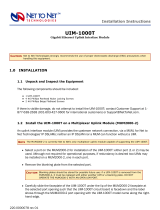
SwitchBlade x8100 Series System Overview | 15
SwitchBlade x8100 Series | System Overview
SwitchBlade x8100 Series – Switch Startup
One of the key differences between the SwitchBlade x8100
Series and other switches running the AlliedWare Plus
operating system is that the SwitchBlade x8100 Series has
multiple CPUs (one on each card). While the CPU on the
master CFC will run the system, because the other control and
line cards have their own CPU and packet processors, they all
need to have a copy of the release software loaded.
Switch startup operation
When the switch starts up, assuming two CFCs are installed,
preference is given to the left-hand side (slot 5) as to which CFC
becomes chassis master. If no CFC is installed in slot 5, then
the right-hand side CFC (slot 6) will become chassis master. To
facilitate this operation, the CFC in the right-hand side delays
asserting mastership, if it detects a CFC in the left-hand side.
This allows the left-hand side CFC to become master. After
waiting for 60 seconds, the right-hand side CFC will assert
mastership, as there is either no CFC in the left-hand slot, or it is
dead or failing to boot.
The CFC boots normally, loading its software release from ash
by default. The CFC runs a DHCP and TFTP server for the line
cards to access the software release over the internal network.
The mechanism employed to accomplish this le transfer from
CFC to the line cards is as follows: The CFC saves a copy of
the running release to a “tftpboot” directory, which the TFTP
server uses to serve releases to the line cards. At startup, the
bootloader on the line card periodically broadcasts a BOOTP
request. The DHCP server is listening on the CFC for BOOTP
requests and it responds with the line card’s management
VLAN IP address, and the release le to boot is sent via TFTP.
When the chassis boots up, the chassis mastership is asserted
as soon as possible. This is in order to start up the TFTP server
on the chassis master so that the line card boot up can occur as
quickly as possible, to minimize the total chassis startup time.
Managing the chassis
The SwitchBlade x8100 Series provides a standard RS-232
asynchronous port, and an Ethernet port for out-of-band
management of the system. Connecting to either asynchronous
port will provide management of the system via the chassis
master. To connect to the system via Ethernet, the Ethernet
port on the master CFC must be used, as the standby CFC’s
Ethernet port is administratively down.
The SwitchBlade x8100 Series has extensive monitoring of
hardware to assist in management of the system. Any problem
with a PSU, Fan etc is detected, and appropriate alarms
generated to let the user know.
Chassis reboot
As mentioned above, which CFC becomes the chassis master is
deterministic, with preference given to the left-hand side (slot 5).
This preference is enforced when the chassis is rebooted from
the command line, or is power-cycled.
CFC fast failover
In the event that the chassis master is hot-swapped out, the
standby CFC will become active master, taking over all control
functions.
The standby CFC runs all network protocol modules and
is kept in sync with the active CFC, so is available in ‘hot-
standby’ for near hitless failover if required. This occurs almost
instantaneously, and testing has shown no noticeable disruption
to a streaming video on a master CFC hot-swap.
Hot-swapping CFCs
The standby CFC can be hot-swapped if required for
maintenance, with no disruption to the system (apart from the
fact that the backplane bandwidth will be temporarily halved).
A newly installed standby CFC will once again double the
backplane bandwidth.
If the master CFC is hot-swapped out, the standby CFC will
assume the role of master almost instantaneously. Now the
right-hand side (and only) CFC is controlling the system. Once a
second CFC is replaced in the left-hand-side slot, it will become
the standby CFC. This new standby CFC will have synchronized
tables with the master and provide double the backplane
bandwidth, but does not take over as master again. If the chassis
were rebooted or power cycled, the left-hand side CFC would
become master again.
Hot-swapping line cards
Line cards can be hot-swapped with no disruption to the
operation of other cards in the system, so trafc continues as
expected across other connections. A newly inserted line card
will utilize the same mechanism described previously to receive
a software release from the master CFC (i.e. a BOOTP request,
with subsequent DHCP internal IP address and TFTP software
release delivery).




















